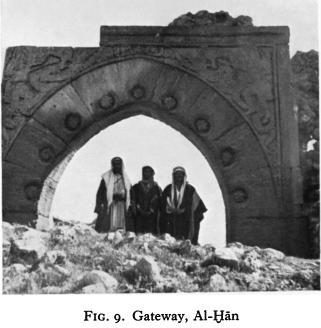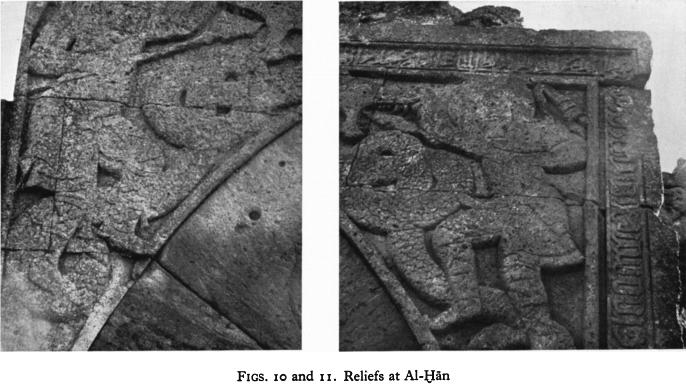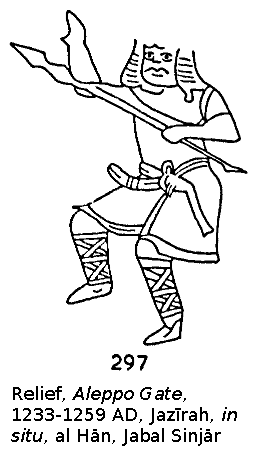Relief, Aleppo Gate, 1233-1259 AD, Jazīrah, in situ, al Hān, Jabal Sinjār.


ḪARĪYYĀT AL-ḪĀN
The ruins, known quite simply as Al-Ḫān, are twenty-two miles west of Tall A‘far and about fifteen from Balad Sinjar.
...
Van Berchem considers that the name Judal refers to Dajdal, the dragons represented in the relief over the monumental gateway (Figs. 9-12).
Two nimbed and bearded figures are depicted, thrusting spears into the mouths of coiled dragons.
The dragon-slayer is identified by Van Berchem with Al-Hidhr, the hero of a Moslem legend based on the life of Saint George the dragon-slayer,
who, at about this period, was translated from Syria to England.
The inscription round the gateway records the construction of the khan by the Zangid sultan of Mosul;
“the pearl of the universe and the faith, the pillar of Islam and the Moslems, the slayer of the unbelievers and the polytheists,
the king of the two Syrias, of Ziyād, and the two Iraqs, the Rustam-i-Zal of this age, the king of the emirs of the sunrise and the sunset,
the glorious Atabeg, Ābū'l-Fadhail Lūlū.”
This flight of imagination refers to Badr ad-Dīn Lūlū, who was not even a Zangid, a Turkish dynasty little more than a century old, but a usurping slave.
He reigned at Mosul, where he built the Qārā Serai palace, from A.D. 1234 to 1258.
He left inscriptions in a number of other buildings beside the Qārā Serai palace:
on the Sinjar gate at Mosul and in the mosque of Yahya Ābū'l-Qasim in the same city and also in the shrine of Sittnā Zainab at Balad Sinjar;
while similar fulsome inscriptions occur on a series of damascened bronze bowls made at Mosul, where that industry was then in its prime.
The reliefs at Al-Ḫān are clearly Christian.
The region was a Christian one and whether this is the inn of Judal which Yāqūt visited or not, it was a Christian inn.
Why should the Atabeg of Mosul dedicate such a place?
That the Christians should have built themselves a grandiloquent khan is not surprising.
Probably the building guilds which were responsible for the renaissance of architecture under the Seljuk Atabegs were Christian.
The churches and monasteries round Mosul show decoration identical with the mosques.
It is possible that the Atabeg put his name to constructions with which he was not really concerned.
Van Berchem points out that Rustam, to whom this inscription compares him, is generally depicted as a dragon-slayer.
Badr ad-Dīn may have noticed the reliefs of Saint George on his travels and seen an opportunity of turning them into a monument to himself,
a subterfuge which dictators of a more enlightened age have not disdained.
Source: "Medieval Antiquities West of Mosul" by Gerald Reitlinger, pp. 143-156 in Iraq Vol. 5 (1938).
The right figure is referenced as figure 297 in The military technology of classical Islam by D Nicolle
297. Relief, Aleppo Gate, 1233-1259 AD, Jazīrah, in situ, al Hān, Jabal Sinjār (ex-F. Stark photographic exhibition, Inst. of Archaeology, London, 1976).

See also a Syriac Gospel, c.1220AD. Ms. Additional 7170, British Library, London.
Reliefs of Horsemen on the Portal, Monastery of Mār Bahnām, Syriac Jazīrah, mid-13th century AD.
Inlaid metal ewer by Shujaʿ ibn Manā, The Blacas Ewer, 1232 AD, Jazīrah (?), British Museum.
Inlaid metal candlestick-base, mid-13th century AD, Ayyūbid Jazīrah, Coll. of Dr. P. Costa.
13th Century Illustrations of Costume & Soldiers




